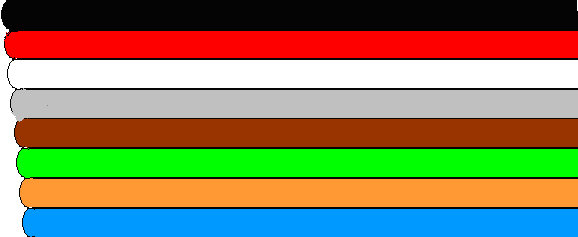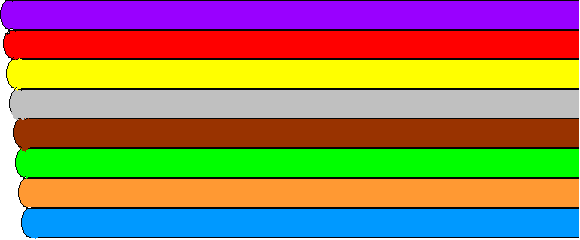Optical transmission hardware integration one-stop service provider
Views: 13 Author: Judy Chang Publish Time: 2021-06-17 Origin: Site
G652 Fiber Core Picture
G657 Fiber Core Picture

Multimode fiber core picture

Our commonly used optical fibers are G652B (blue, orange, green, brown, gray, white, red, black) and G657A (blue, orange, green, brown, gray, yellow, red, purple), the difference between the main characteristics of the two optical fibers It is the bending radius of the optical fiber, G652B is R30 (the bending radius of the optical fiber cannot be less than 30mm), and G657A is R10 (the bending radius of the optical fiber cannot be less than 10mm)




Arrangement order of G657 fiber
Knowledge of fiber type:
ITU-T recommended specification classification: G.651, G.652, G.653, G.654, G.655, G.656, G.657
MMF (Multi Mode Fiber)
-OM1 fiber (62.5⁄125um)
-OM2⁄OM3 fiber (G.651 fiber) Among them: OM2—50⁄125um; OM3—a new generation of multimode fiber.
SMF (Single Mode Fiber)
-G.652 (dispersion non-shifted single-mode fiber)
-G.653 (dispersion shifted fiber)
-G.654 (cut-off wavelength shifted fiber)
-G.655 (non-zero dispersion shifted fiber)
-G.656 (low slope non-zero dispersion shift fiber)
-G.657 (bend-resistant fiber)
◆G.651: Long-wavelength multimode fiber (ITU-T G.651) 50/125μm gradient multimode fiber industry standard. Established in the late 1970s and early 1980s. ITU-T G.651 is OM2⁄OM3 fiber or multimode fiber (50⁄125). There is no OM1 fiber or multimode light (62.5⁄125) in the ITU-T recommended fiber, but they are still very common in the United States. Mainly used in local area networks, not suitable for long-distance transmission, but in the range of 300 to 500 meters, G.651 is a low-cost multimode transmission fiber.
◆G.652: Conventional single-mode fiber (dispersion non-shift single-mode fiber), with the shortest cut-off wavelength, which can be used for both 1550NM and 1310NM. Its characteristic is that the dispersion is zero when the wavelength is around 1310nm during design and manufacturing, and the loss is the smallest at 1550nm, but the dispersion is the largest. (The attenuation of 1310nm window is 0.3~0.4dB/km, the dispersion coefficient is 0~3.5ps/nm.km. The attenuation of 1550nm window is 0.19~0.25dB/km, and the dispersion coefficient is 15~18ps/nm.km.) Main The disadvantage is that the dispersion coefficient is relatively large in the 1550 band, which is not suitable for long-distance applications above 2.5Gb/s.
G.652A⁄B is a basic single-mode fiber, and G.652C⁄D is a low-water peak single-mode fiber.
◆G.653: Dispersion-shifted single-mode fiber. Dispersion around 1550nm wavelength is minimized, thereby minimizing light loss.
◆G..654: Cut-off wavelength shifted fiber. The attenuation coefficient is the lowest at 1550nm (approximately 15% lower than G.652, G.653, and G.655 fibers), so it is called a low-attenuation fiber. The dispersion coefficient is the same as that of G.652, which is the least actually used fiber. It is mainly used for long-distance transmission under the sea or on the ground, such as a 400-kilometer line without a transponder.
◆G.655: Non zero-Dispersion-Shifted Fiber (NZ-DSF: Non zero-Dispersion-Shifted Fiber). G.653 fiber has zero dispersion at 1550nm wavelength, while G.655 fiber has concentrated or positive or negative dispersion, which reduces the adverse effects of nonlinear phenomena that interfere with adjacent wavelengths in the DWDM system.
The first-generation non-zero dispersion-shifted fiber, such as PureMetro fiber, has the advantage that the dispersion per kilometer is equal to or lower than 5ps⁄nm, which makes the dispersion compensation easier.
The second-generation non-zero dispersion-shifted fiber, such as PureGuide, has a dispersion of about 10 ps⁄nm per kilometer, which doubles the capacity of the DWDM system.
◆G.656: Low slope non-zero dispersion shift fiber. A type of non-zero dispersion-shifted fiber that has strict requirements on the speed of dispersion, ensuring the transmission performance in a larger wavelength range in the DWDM system.
◆G.657: Bend-resistant fiber, also called bend-insensitive single-mode fiber, with a minimum bending radius of 5-10mm. In the ITU-T G657 standard, it is required: G657 is divided into two sub-categories A and B, and the sub-categories are divided into four sub-categories A1, A2, B2, and B3. Among them, category A is fully compatible with G652D fiber, and category B does not need to be traditional Single-mode fiber is compatible in connection. The available wavelength of type A is: O+E+S+C+L; the available wavelength of type B (suitable for short-distance communication) is O+C+L. At the same time, the minimum bending radius of G657A1 is 10mm, and the minimum bending radius of G657A2 is 7.5mm (diameter is 15mm, one circle, wavelength is 1550nm, maximum loss is 0.5dB; diameter is 20mm, maximum loss is 0.1dB; diameter is 30mm, maximum loss is 0.03 dB), the minimum bending radius of G657B2 and G657B3 is 5mm. G657 is a new product based on the needs of FTTx technology and assembly applications. It was introduced in 2006 and the leading manufacturer is Drake Communication Technology.

◆Superior fiber: 10G Ethernet multi-mode fiber.
Characteristics of G.652.A, G.652.B, G.652.C and G.652.D fiber optic cables
